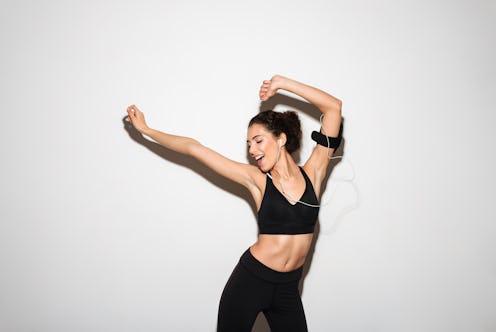(Living)
What You Need To Know Before Trying The Dance Fitness Trend

Whether your best moves are reserved for your home-alone-in-your-underwear time, the dance floor at your favorite club, or your local fitness studio, you've probably — at some point or another — discovered that dancing is at very least fun, and at most downright transformative, even if you think you're not very good at it. And if you've spent a period of time shaking, twirling, and hip-circling to music to the point of breaking a sweat, it may come as no surprise that dance fitness classes have become one of the biggest workout trends of late. But are they actually effective?
Dance-centric fitness classes and wellness events are popping up all over the place these days, and appealing to health and exercise enthusiasts as well as those who typically don't set foot into a gym. Why? Well, Radha Agrawal, co-founder of Daybreaker and former professional athlete chalks it up to the feel-good factor it produces. And that's one of the main reasons these roving, sober, early morning dance parties were dreamed up in the first place.
"Dancing is the most celebratory form of expression and in the wild times we are living in, we need reasons to celebrate," says Agrawal, who even coined a term for the benefits one gets from a fitness experience such as Daybreaker: DOSE, an acronym for dopamine, oxytocin, serotonin, endorphins."The dopamine you get from listening to joyful music, the oxytocin you get from dancing with others, twirling people around, the contact high of being with a group of people, the serotonin you get from feeling a sense of connectedness with others and meaning, and the endorphins you get from moving your body and sweating! No other workout allows for the release of all four happy brain chemicals — it's unique to dance."
Beyond the happy brain chemicals dancing can trigger, it's decidedly a legitimate muscle-toning, heart-pumping, full-body workout, which is why studios like Body by Simone have designed workouts rooted in dance. "Dance based fitness is unique because it works your body and your mind at the same time," says BBS instructor Jillian Forster. "Numerous studies show that dance is proven to benefit your mood, mental health, and physical health."
And while one of the things to love about dance is that you can do it practically anywhere without props or equipment (though many popular dance-based workouts do incorporate things like light dumbbells, resistance bands or even trampolines), like other types of cardio, to get the most effective workout and not be too strenuous on the body, there are some things you should keep in mind. "A proper warm up and cool down is essential," says Forster. "[At Body By Simone] we have a set warm up that we start every class with to ensure our clients are prepared for the work ahead, and then we have a set cool down of stretches that is performed at the end of the workout to help avoid injuries and unnecessary soreness." Even Daybreaker's morning raves begin with a yoga flow or instructor-led warm up. Would you go for a long run without a thorough stretching session? The same applies to dance.
Forster also recommends alternating between toning focused classes and cardio focused ones, so you're reaping the most benefits. "You also want to ensure that you include a minimum of one rest day in your week for muscle recovery," she says. "Your rest day can always include yoga, stretching, foam rolling, and a nice long leisurely walk." Besides that, the only things to bear in mind are wearing clothing and footwear that's comfortable, supportive, and makes you feel confident, and having fun — even if you can't totally keep up with the steps.